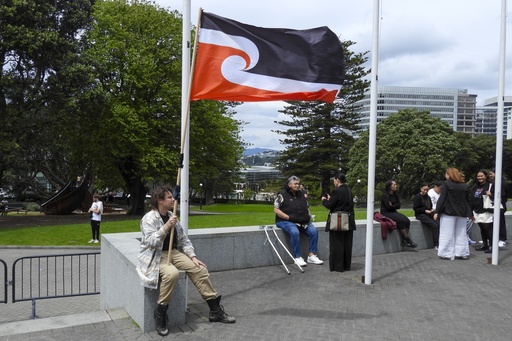
WELLINGTON, New Zealand — A newly introduced bill aiming to alter New Zealand’s foundational treaty between the British Crown and M?ori chiefs has sparked significant political upheaval and led to a large-scale march across the nation culminating in Parliament.
While the bill is not anticipated to pass into law, it has ignited intense debate regarding race relations and shines a light on the complex 180-year dialogue about the commitments made to Indigenous populations during colonization and the nature of those promises.
On Tuesday, the final leg of the week-long protest is expected to draw tens of thousands of participants to Wellington, where demonstrators will engage in a traditional M?ori practice known as h?koi, or walking, to highlight the ongoing violations of the 1840 Treaty of Waitangi.
This treaty, regarded as the cornerstone of New Zealand’s founding, was agreed upon by representatives of the British Crown and around 500 M?ori chiefs during the country’s colonization. It established guiding principles meant to govern the relationship between the Crown and M?ori through two distinct versions: one in English and the other in M?ori.
The treaty promised M?ori the same rights and privileges as British citizens; however, discrepancies between the English and M?ori versions raising questions about the extent of authority relinquished by the chiefs over their land, autonomy, and affairs.
Throughout the years, the Crown violated both translations of the treaty, leading to a decline in M?ori language and culture by the mid-20th century. Indigenous peoples often faced barriers to practicing their culture, while extensive tribal lands were confiscated, resulting in significant socio-economic disadvantages.
The last five decades have seen a revival of treaty rights, largely driven by a resurgence of M?ori activism. Courts, lawmakers, and the Waitangi Tribunal—a dedicated body established to resolve treaty issues—have engaged in interpreting the treaty’s varying versions to address these breaches and solidify the meaning of its guiding principles through their rulings.
These principles are loosely defined but generally emphasize partnership with the Crown, safeguarding M?ori interests, and enhancing M?ori participation in governance.
Although many disparities persist that affect M?ori, the recognition of treaty rights has reshaped New Zealand society. There has been a resurgence of the M?ori language, with many words now circulating in everyday use, including among non-M?ori speakers. Policies have been initiated to tackle common inequities faced by M?ori communities.
Moreover, billions of dollars have been negotiated in settlements with various tribal groups addressing treaty violations, particularly regarding the confiscation of M?ori lands and natural resources.
However, a segment of the New Zealand population expresses discontent with these reparative measures. Lawmaker David Seymour, the leader of a smaller libertarian party that secured under 9% of the vote in the recent election, has emerged as a key figure opposing the current framework.
Seymour’s proposed legislation seeks to establish clear definitions for the treaty’s principles and extend their applicability to all New Zealanders rather than exclusively to M?ori. He contends that the current piecemeal interpretations of the treaty’s essence have created confusion and inadvertently favored M?ori.
His proposal has met significant resistance from a variety of quarters, including former prime ministers from both political spectrums, a coalition of 40 senior legal professionals, and thousands of M?ori and non-M?ori citizens participating in the march.
Though Seymour’s bill successfully passed an initial vote due to political maneuvering, it is not likely to survive its final reading, as many who supported it previously are expected to withdraw their backing.
Critics argue that the legislation poses a risk of constitutional disruption and could dismantle the rights guaranteed by the treaty that have since been enacted into law. They also accuse Seymour, who identifies as M?ori, of inciting hostility toward Indigenous communities.
The peaceful marches are rooted in M?ori tradition and have historically been used to highlight critical issues surrounding treaty rights.
Authorities anticipate that approximately 30,000 individuals will converge on Wellington for the march on Tuesday, with additional crowds of up to 10,000 assembling in cities along the route leading to the capital.
Many participants are protesting against Seymour’s bill; however, others are also voicing opposition to various policies from the current government concerning M?ori affairs, including a directive initiated by Seymour advocating for public institutions to refrain from creating specific policies aimed at addressing M?ori inequalities.
